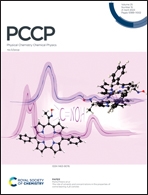In situ study of catalytic CO oxidation on ultrathin MgO film supported Pd nanoparticles by sum frequency generation: size and site effects†
Abstract
Controlling the reactive sites of nanoparticles (NPs) is crucial to improve catalyst efficiency. In this work, sum-frequency generation is used to probe CO vibrational spectra on MgO(100) ultrathin film/Ag(100) supported Pd nanoparticles ranging from 3 to 6 nm in diameter and compared to those of coalesced Pd NPs and Pd(100) single crystals. We aim to demonstrate in situ the role played by active adsorption sites in the catalytic CO oxidation reactivity trends varying with the NP size. From ultrahigh vacuum to the mbar range and temperatures from 293 K to 340 K, our observations suggest that bridge sites are the main active sites for CO adsorption and catalytic oxidation. On Pd(100) single crystals at 293 K, CO oxidation predominates over CO poisoning at a pressure ratio of O2/CO greater than 300; on Pd NPs, both the site coordination due to NP geometry and MgO-induced Pd–Pd interatomic distance change impact the reactivity trend varying with size in different ways. Edge sites with low coordination are more reactive than facet sites, while facet sites with a smaller Pd–Pd atomic length are more reactive than that with a larger length. The interplay of both site and size effects gives rise to a non-monotonic reactivity trend of CO on the MgO(100) ultrathin film supported Pd NPs: the reactivity of Pd NPs increases for the smaller NP size side due to a higher edge/facet ratio and meanwhile increases for the larger NP size side due to the terrace facet with a smaller Pd–Pd atomic length at the NP surface and a lower diffusion barrier.



 Please wait while we load your content...
Please wait while we load your content...